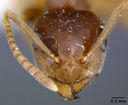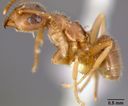Black Garden Ant
Lasius niger
Classification
- Phylum: Arthropoda
- Subphylum: Hexapoda
- Class: Insecta
- Order: Hymenoptera
- Superfamily: Formicoidea
- Family: Formicidae
- Subfamily: Formicinae
- Tribe: Lasiini
- Genus: Lasius
- Species: niger
Pronunciation
How to pronounce Lasius niger: //ˈlæsiəs ˈnaɪdʒər//
These audio files are automatically generated. While they are not always 100% accurate, they are a good starting point.
Images






Summary
The Black Garden Ant (Lasius niger) is a prevalent ant species in Europe and parts of North America, recognized for its dark coloration and social structure. It plays crucial ecological roles through mutualism and predator control.
Physical Characteristics
A dark brown, nearly black Lasius with erect hairs on the antennal scapes.
Identification Tips
Small black ant, commonly referred to as the common black ant.
Habitat
Fields, human habitat.
Distribution
Found across Europe, parts of North America, South America, Asia, and Australasia. Well established in eastern Canada, especially Quebec, and also occurs in the Pacific Northwest and southwestern Canada.
Diet
Lasius niger feeds on honeydew produced by aphids, as well as other sugary substances and protein sources.
Life Cycle
Life cycle includes four stages: egg, larva, pupa, and adult. Queens exhibit significant longevity, living up to 29 years, while workers live for several months.
Reproduction
Lasius niger is monogynous, usually having one queen per colony. Mating occurs during nuptial flights from June to September.
Ecosystem Role
Acts as a protector of aphids and engages in mutualistic relationships with various organisms.
Similar Taxa
Misconceptions
Some may confuse L. niger with other small black ant species.
Tags
- Lasius niger
- Black Garden Ant
- common black ant
- social insects